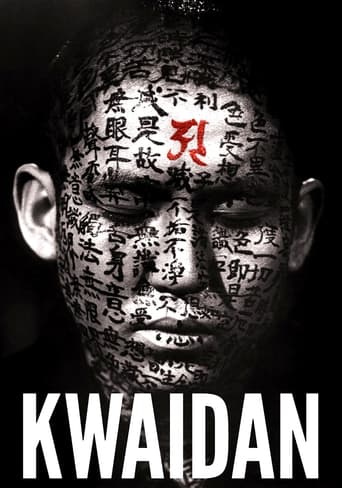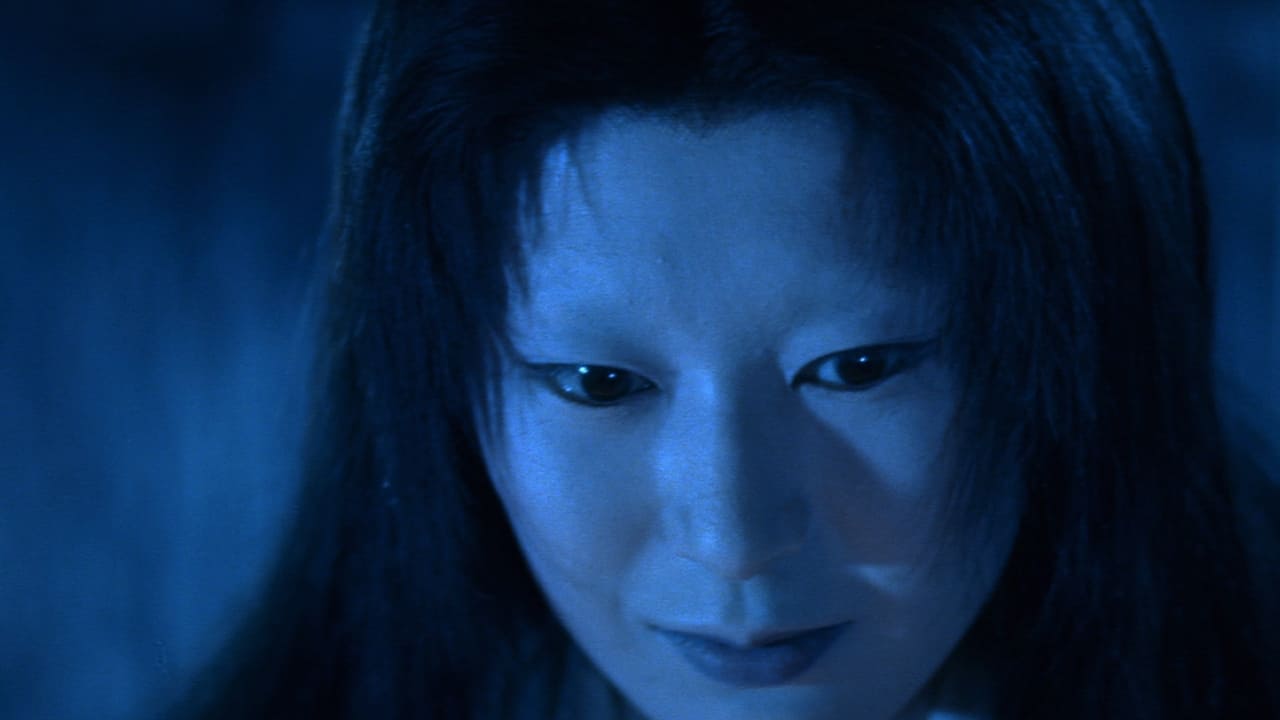WILLIAM FLANIGAN
Viewed on DVD. Interior set design/decoration = nine (9) stars; restoration = five (5) stars; sound = four (4) stars; "score" = two (2) stars. Director Masaki Kobayashi has strung together four short stories that come across more as one-act theater plays than as film shorts. This overly long production suffers from the major flaw of telling ghost stories that are NOT scary! Each act proceeds at glacial pace without even a surprise ending (the script telegraphs the final outcomes well in advance). After putting what appears to be a major chuck of his production budget into lavish sound-stage sets, the Director does not seem to have had much left over for ghost effects, aside from jump cuts, basic stage-like lighting (spot lights, fades to and from dark, etc.), and primitive optical dissolves. Acting is mostly bland and undistinguished. Cinematography (wide screen, color) and set design are excellent. Scene lighting is often too dark, especially for interiors. (This is a shame, since it reduces the impact of the film's spectacular sets as well as the body language and facial expressions of the actors.) Restoration fails to remove wear lines that appear during the opening credits and periodically in each story. Often the sound track sounds like there is a washing machine operating in the background. The long opening credits are almost totally silent. (So don't panic and think that your audio system has failed!) Much of the film's "score" consists of bizarre, random sounds/noises unrelated to what is taking place on screen. Be prepared to be disappointed. WILLIAM FLANIGAN, PhD
gavin6942
A collection of four Japanese folk tales with supernatural themes.In his Harakiri review, Roger Ebert described Kwaidan as "an assembly of ghost stories that is among the most beautiful films I've seen". True, Roger, true. A beautiful film, one of the best Japanese films, and probably the single best Japanese horror film ever made. Everything that came out of Japanese later (in the 1990s) owes a little something to this film.Sure, you could say, "But wait, the greatest Japanese horror film is Godzilla." And there is plenty of truth to that. But Godzilla is a whole other category, both in and outside of horror. There was really never anything scary about giant monsters beating on each other.
colaya
"Stylish... no substance". "Predictable plot". "Boring stories". "Lack of dramatic elements". "The tales are unrelated".As if movies were drama (or literature) with a camera...As if movies were to be "understood", instead of be experienced...Kwaidan is vibrant aesthetic expression, colors, camera movements, angles, edition, sound, music, set, makeup, costumes, all skilfully crafted to produce sensations---horror, suspense, curiosity, surprise, discomfort, even laughter. In this sense Kwaidan fully delivers. A "moving picture" indeed that makes the most of its proper language and form---"pure cinema" in words of Hitchcock, the "cinematography" of Bresson. Some reviewers seem to be missing the party, to focus on "the plot" is perhaps to miss the whole point. "Realistic, character-driven, complex plot" is just one option for judging a film, the most inadequate perhaps (such elements are surely best delivered through a book or a play, by far...).And nevertheless, Kwaidan's "plot" is also able to speak for itself. A common theme across the four tales is "how to tell (film) a story about storytelling", a Borgesian mirror (the real horror) that is fully exposed in the 4th tale in which the storyteller leaves the story unfinished apparently because of the very same type of ghost that he was writing (filming?) about... It is Kobayashi's disclaimer (and hint) about film and fiction: the author (director) is trapped in its own convention (medium) jointly constructed with the audience---as Borges put it: "Films are even stranger than theater, for what we are seeing are not disguised people but photographs of disguised people, and yet we believe them while the film is being shown".Kwaidan is cinematography---pure cinema---a beautiful film to be experienced. If you want "a plot to understand", "to scream", or just "to be entertained", look elsewhere.
tomgillespie2002
Based on the writings of Lafcadio Hearn, who studied Japanese folklore and supernatural tales to form his novel Kwaidan: Stories and Studies of Strange Things, Kwaidan tells four stories, all varying in length, tone, and quality. The first, The Black Hair, depicts a samurai who abandons his loving wife in search of a rise in the social hierarchy, marrying into wealth after displaying his fine gift for archery on horseback. Spending years in deep regret, he returns back to his first wife only to find her physically the same, yet entirely different. The second, The Woman of the Snow, is a very simplistic tale of a man's encounter with the Yuki-onna, a pale woman with blue lips who lives in the snow, who warns the man that she would kill him if he told anyone about her.The stand-out segment is undoubtedly the third, Hoichi the Earless, a sweeping epic (in a portmanteau context) tale of a blind musician, Hoichi (Katsuo Nakamura), who's rendition of The Tale of the Heike (a multi-layered account of the long-standing conflict between the Taira and Minamoto clans in 12th century Japan), has gained him renown. The ghost of a warrior that perished during the decisive Battle of Dan-no- ura approaches Hoichi, informing him that his lord has demanded his presence in order to hear his legendary performance. After frequently disappearing during the night, Hoichi is followed and is seen to be playing to a graveyard full of ghosts. The fourth, which is the shortest, is the unfinished story In a Cup of Tea.Winner of the Grand Jury Prize at Cannes and nominated for the Best Foreign Language Film at the 1965 Academy Awards, Kwaidan is a masterwork of visual splendour, using bold explosions of colour, Expressionist sets, and dream-like, almost fairytale lighting. Hoichi the Earless begins with a beautiful re-telling of the Battle of Dan-no- ura, with lavish red and orange back-drops juxtaposed with the microscopically detailed artwork from the period, making it seem almost like a painting come to life, all with the sound of Hoichi's beautiful rendition of The Tale of the Heike. This comes straight after the rather gloomy Woman of the Snow, which uses blue lighting amidst a snowy terrain to create the most haunting of the tales on show.Yet Kwaidan is much more than visual elegance. It is deeply rooted in Japanese folk-lore, bringing to mind the Western tales of the Brothers Grimm, back when fairy-tales had a darker tone and social context. It is almost like lying in bed on a thunderous night reading ghost stories by candle-light. Director Makasi Kobayashi (director of The Human Condition trilogy (1959-1961) and Harakiri (1962)) seems especially fascinated and enchanted by these tales, giving each story its own visual style and colour scheme, and even dedicating the final segment to the many unfinished Japanese stories that end abruptly, shrouded in mystery, and ponders the fate of its author.Running at three hours, Kwaidan never feels strained or tired, and doesn't waste a second of its running time to create something you could easily freeze-frame and hang on your wall. Hoichi the Earless could have been a masterpiece on its own, and is the most fondly remembered of the quartet (the image of Hoichi screaming, clutching his butchered head has become iconic amongst fans of more obscure, art-house 'horror'). The final story does end the film on a sadly quite anti-climactic note however, being by far the poorest of the stories, telling a slightly silly, un-involving twenty-minute story about the reflection of a mysterious man in a cup of tea that appears later to a confused samurai. It jars with what came before, slightly ruining what is a nigh-on perfect trilogy of beautifully rendered films.www.the-wrath-of-blog.blogspot.com



 AD
AD






